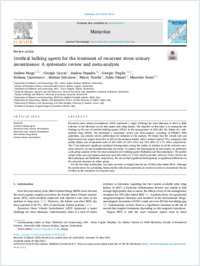Urethral bulking agents for the treatment of recurrent stress urinary incontinence : a systematic review and meta-analysis
- Braga, Andrea Department of Obstetrics and Gynaecology, EOC - Beata Vergine Hospital, Mendrisio, Switzerland ; Faculty of Biomedical Sciences, Università della Svizzera italiana, Switzerland
- Caccia, Giorgio Department of Obstetrics and Gynaecology, EOC - Beata Vergine Hospital, Mendrisio, Switzerland
- Papadia, Andrea ORCID Faculty of Biomedical Sciences, Università della Svizzera italiana, Switzerland ; Department of Obstetrics and Gynaecology, EOC – Civico Hospital, Lugano, Switzerland
- Treglia, Giorgio ORCID Faculty of Biomedical Sciences, Università della Svizzera italiana, Switzerland ; d Academic Education, Research and Innovation Area, General Directorate, Ente Ospedaliero Cantonale, Bellinzona, Switzerland ; Faculty of Biology and Medicine, University of Lausanne, Lausanne, Switzerland
- Castronovo, Fabiana Department of Obstetrics and Gynaecology, EOC - Beata Vergine Hospital, Mendrisio, Switzerland
- Salvatore, Stefano Department of Obstetrics and Gynaecology, IRCSS San Raffaele Scientific Institute, Milan, Italy
- Torella, Marco Department of Gynaecology, Obstetric and Reproductive Science, Second University of Naples, Naples, Italy
- Ghezzi, Fabio Department of Obstetrics and Gynaecology, Del Ponte Hospital, University of Insubria, Varese, Italy
- Serati, Maurizio Department of Obstetrics and Gynaecology, Del Ponte Hospital, University of Insubria, Varese, Italy ; President of European Urogynaecological Association (EUGA), Italy
- 2022
Published in:
- Maturitas. - 2022, vol. 163, p. 28–37
Urethral bulking agent
Recurrent stress urinary incontinence
Persistent stress urinary incontinence
Mid-urethral sling failure
Female urinary incontinence
English
Recurrent stress urinary incontinence (rSUI) represents a major challenge for most clinicians as there is little evidence in the literature on the best option after sling failure. The objective of this study is to summarise the findings on the use of urethral bulking agents (UBAs) in the management of rSUI after the failure of a mid- urethral sling (MUSs). We performed a systematic review and meta-analysis, according to PRISMA 2020 guidelines, and selected eleven publications for inclusion in the analysis. We found that the overall cure and improvement rate ranged from 64% to 85% in the included studies, with a pooled value of 75%, compared with pooled failure and re-operation rates of 32% (95% CI: 22%–43%) and 25% (95% CI: 17%–34%), respectively. The I2 test indicated significant statistical heterogeneity among the studies in relation to all the outcome mea-sures; however, no risk of publication bias was found. To explore this heterogeneity in more depth, we performed a sub-group analysis of the two most commonly used bulking agents (Bulkamid and Macroplastique). The pooled values of the cure and improvement rate were 84% (95% CI: 77.0%–90.0%) and 80% (95% CI: 74.0%–85.0%) for Macroplastique and Bulkamid, respectively. We did not find significant heterogeneity or significant differences in the outcome measures in either group. For the first time in literature, our study provides an insight into the use of UBAs after failed MUSs. Although the results seem very promising, future studies with shared protocols are needed in order to recommend the use of UBAs in the treatment of recurrent cases.
- Collections
- Language
-
- English
- Classification
- Medicine
- License
- Open access status
- hybrid
- Identifiers
-
- DOI 10.1016/j.maturitas.2022.05.007
- ARK ark:/12658/srd1324965
- Persistent URL
- https://n2t.net/ark:/12658/srd1324965
Statistics
Document views: 141
File downloads:
- Braga_2022_Else_maturitas: 289
